B2B case studies are among the most valuable forms of marketing for buyers. When researching prospective purchases, they want to know what problems your business solved for other customers and the positive results. Case studies show them that they can achieve similar outcomes.
Trust is key in B2B buyers’ decision-making. If they don’t perceive your business as trustworthy, they’re not going to buy from you. Seeing the successes others have had in using your products and services shows they can trust your solutions. As a result, your company will be primed to attract new business and upsell current customers.
This post covers:
How to create B2B case studies in 12 steps
- Identify your case study candidates.
- Select your format(s).
- Contact customers to ask if they’ll participate.
- Set expectations and explain the process.
- Gather basic information about your customers.
- Send customers your case study questions before you interview them.
- Schedule your interviews.
- Conduct your interviews.
- Create your B2B case studies.
- Manage reviews and approvals.
- Promote your case studies.
- Start working on the next round.
5 B2B case study examples and why they’re effective
What to include in B2B case studies
Case studies have four parts:
- The customer’s problem
- Your company’s solution
- Your customer’s results
- A call to action (CTA)
Your prospective customers want to know “what’s in it for me?” if they choose your products and services. Case studies should make the benefits clear through your customers’ eyes. By sharing their stories and positive outcomes, buyers can have confidence in your offer.
Results buyers care about
Being specific is key in case study content. The more positive data you can share, the better. Buyers always want to increase revenue and reduce costs, so focus on those results. Other positive outcomes include:
- Business growth
- Market growth
- Time savings
- Efficiency improvements
- Quality improvements
When thinking about the benefits that buyers care about, put yourself in their shoes. Let’s say you’re shopping for a new product or service, what do you look for in a company? Do you care that the business is “award-winning,” or do you want to boost revenue? Always make the story about them – not your company. In other words, make your customers the heroes of your stories.
Case study formats
You can create and share B2B case studies in many formats. Go as big as possible so that your marketing and sales teams will have a variety of assets they can share across channels and platforms. Here are the formats and how you can use them:
- Video case studies: Videos increase engagement because buyers want to see and hear your customers talk about using your products and services. You can share them on your website and social media channels and in blogs, email campaigns and e-newsletters. They should be short – no more than 1-2 minutes each.
- Website case studies: This format offers the greatest flexibility. Website case studies are usually short and focus on customer challenges, your solutions and the outcomes. You can package these with complementary assets that include:
- Eye-catching graphics
- Video case studies
- Video or written customer testimonials
- Graphics, including infographics
- Articles about your products and services
- White papers
As with video case studies, you can promote these on your social media channels and in blogs, email campaigns and e-newsletters.
- Standalone PDF case studies: These are long-form versions of website case studies, without the videos, of course. Salespeople can use them as leave-behinds or email them to prospects. In addition, you can add these to your website for buyers to download.
- Sales deck slides: Punch up sales presentations with case study snapshots. Use the most impressive customer results and quotes to get buyers’ attention.
How to create B2B case studies in 12 steps
Next, let’s look at how to create your case studies. Follow the steps below and get answers to common questions.
1. Identify your case study candidates.
Not all customers make great case studies. Even the best writers can’t turn an underwhelming customer experience into a mind-blowing story. Case studies should feature your most impressive results.
Here’s how to do it:
- Start by making a list of the biggest challenges you helped customers overcome. Don’t worry about fine-tuning. List as many notable examples as you can. Check with your sales and customer service teams. Since they’re on the front lines, they can offer valuable suggestions.
- Once you’ve got a list, see if any names stand out. Are there any notable brands? Marquee names carry more weight than lesser-known companies. Focus on those first. One caveat: Large brands can be difficult to pin down. They may have policies that prohibit endorsements, which is what case studies are. Others may require you to get approvals from legal and marketing departments. Don’t worry about that yet, however.
- If you don’t have big-name success stories, focus on smaller customers. Think of convincing examples that show your value and great customer outcomes.
- Refine your list to 10-15 customers. These are the customers you’ll contact for permission to feature them. Some will say no, and others won’t get back to you. For this reason, you’ll want to have a few extra candidates. You can add success stories later once you complete the initial batch.
2. Select your format(s).
Before you contact your list of 10-15 customers, think about how to present their stories in ways that align with your marketing strategy and business goals. Consider your customers as well. Are they nervous behind a camera? Do they have limited time to speak with you? Maybe they’ll only give you a quick quote or two.
If there’s a chance your customers will agree to video case studies, I’d choose that format. It allows you to repurpose the content in multiple ways, including:
- Video and written testimonials
- Written case studies
- Blog posts
- Email campaigns
- Social media posts
- Sales presentations
For those customers who aren’t video-ready, you can still do a lot with written case studies. You can create:
- Long-form, standalone PDFs
- Short-form website content
- Testimonials for your website and sales presentations
- Blog posts
- Email campaigns
- Social media posts
- Sales presentations
3. Contact customers to ask if they’ll participate.
Now that you’ve identified your case study candidates and the format(s) you’d like to use, it’s time to contact your customers and get their buy-in. Be prepared to provide the following information:
- The products/solutions you want to feature
- Your deadline
- Who you plan to interview
- Your preferred format
- How you’ll use the case study and where you’ll publish it
- How you’ll promote it
4. Set expectations and explain the process.
Once they agree to participate, customers will want to know your case study process. As a result, plan to explain the steps in detail. Most importantly, confirm:
- What you need from them
- How much time it will take
- What you’ll do to help them prepare
- How you’ll handle reviews and approvals
- Next steps if they agree to participate
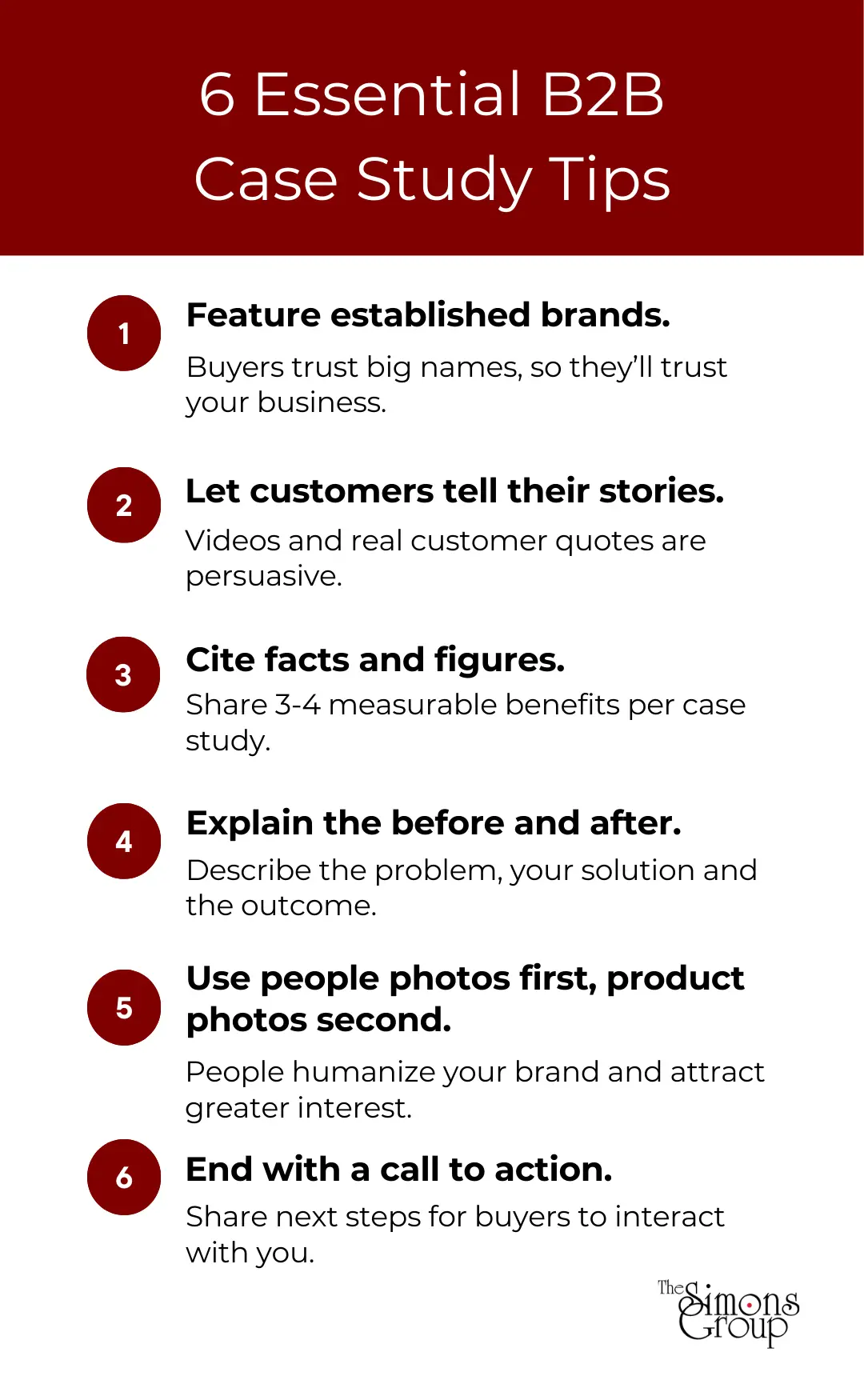
What if my customers want anonymity?
Companies may want you to refrain from naming their businesses or attributing quotes to their employees. Before you agree to these requests, try to identify their underlying concerns. Perhaps no one asked them for attribution in the past, and they’re not familiar with other approaches. Or they fear competitors could benefit by reading details about their products and services.
Once you learn why, you may be able to change their minds. In weighing how comfortable you are with these discussions, consider:
- Whether their companies are big-name brands
- How important they are to your business
- The length and strength of your relationships with them
- The significance of the challenges you solved for them
- How impressive the outcomes are that they achieved from your products and services
For example, if a national brand doubled its revenue and market share with your solutions, you’d want to press for attribution. On the other hand, if you’re working with a small business that increased sales by 2% after using your products, the effort wouldn’t be worth it.
Whatever the case may be, it’s best practice to include business names, and names and titles of those you quote. Why? Attribution improves your company’s credibility. Buyers want to know who you’re solving problems for and how. Above all, they want to read or hear it in your customers’ words rather than through the filter of your marketing team. As a result, cases studies are more believable when you cite names than when you don’t.
Some customers still don’t want me to identify them. What now?
Don’t be surprised if some of your customers who had outstanding results insist on anonymity. In these situations, ask them if you can reference their brands broadly. For example, “a prominent Midwest real estate developer” or a “global financial firm.” This might be your best option versus having no case studies.
If your customers leave you no choice but to go the anonymous route, be sure those case studies feature remarkable results. Make them the best stories they can possibly be. However, if you’re dealing with average customer results and businesses that don’t want to be identified, don’t move forward. Instead, focus on building future successes that you can promote.
My customers aren’t all in. How can I get them to commit?
Some brands may be reluctant to participate for reasons that have nothing to do with being identified. They may not have time, or they may worry about revealing sensitive information. Meanwhile, others may not see any benefit to helping you create case studies. If they hedge, tell them their businesses will receive publicity and exposure.
Similarly, the content can create awareness for their brands. They’ll get a boost if you share the case studies on your website and social media channels. Furthermore, when you @mention them, it will increase their visibility even more. If they still decline to participate, contact the next customer on your list.
While you might be tempted to offer an incentive, such as a discounted or free service, to get them to cooperate, don’t do it. Enticements create the perception of bias and make your company look desperate. It’s similar to paying customers to participate in a survey. You’ve worked hard to build up your brand; don’t destroy it with freebies.
5. Gather basic information about your customers.
Now, if you’ve got a solid list of customers who’ve committed to help you, it’s time to prepare for your interviews with them.
First, you’ll need to pull background about your customers to include in your case studies. Most, if not all, of the information should be on their websites. If you don’t know the answers and can’t find them, ask your customers to fill in any holes over email or when you interview them.
Here’s the background you’ll need:
- The year their companies were founded
- Their annual revenue or sales
- How many employees they have
- Where they’re headquartered
If you’re shy about requesting their revenue/sales, it’s easily available for public companies. Look for the investor relations sections on their websites. This is usually where they keep financial reports, including profit and loss statements. Public companies must post the information by law.
In contrast, you’ll have a tougher time finding revenue/sales for private companies. They’re not required to disclose financial information to the public. Financial websites, including Bloomberg, Reuters and Forbes, publish financial data for select privately held businesses.
If you can’t find the information and you’re not comfortable asking your customers for it, omit this detail from your case studies. It’s nice to have – particularly for large companies – but it won’t affect your content quality.
6. Send customers your case study questions before you interview them.
After your customers agree to participate, email them your interview questions. They’ll appreciate being able to think about their answers before you speak with them. You’ll need to tailor your questions to each customer’s situation, but here’s a general list to get you started:
- What problems were you facing when you chose our products/services?
- Did you consider/try other solutions before working with us? What happened?
- Why did you choose our products/services?
- Describe how you implemented our solutions, whether you encountered any challenges along the way, and how we helped resolve them.
- How are you benefiting from our products/services? Please provide specific results and success metrics.
- Would you recommend our products/services to others? Why?
7. Schedule your interviews.
For each case study, schedule 30- to 60-minute interviews. During each interview, you’ll want to get detailed answers to the questions you emailed. Most importantly, don’t rely on emailed responses. You won’t be able to get the information and quotes you need to create high-quality content. Remember, if you start with full video interviews, you’ll be able to repackage them into other assets.
8. Conduct your interviews.
If you’re creating video case studies, you’ll want to be sure you and your customers have good lighting and professional-looking backgrounds. In particular, poor lighting can ruin your best efforts. Take advantage of free, natural lighting. If you have the budget for it, you can hire a videographer for half- or full-day shoots. But those costs can add up quickly, especially if you’re interviewing multiple customers.
As an alternative, you can use a video editor and maker and save a bundle. Many apps are free for basic features. Most have built-in artificial intelligence that makes it easy and quick to create great video content. Examples include:
Whether you hire a pro or shoot videos yourself, you can upload the files to a speech-to-text tool, such as Otter.ai or Transcribe. These tools generate written interview transcripts quickly. With the transcripts in hand, you’ll be able to create short- and long-form stories, blog posts, social media posts, customer testimonials and sales materials.
If you’re not going to create video case studies, you’ll still want to record your customer interviews. That way, you’ll be able to capture everything they say. You can use Microsoft Teams, Zoom or other videoconferencing software to record and transcribe your conversations.
When you finish your interviews, be sure to thank your customers for their time. Then, tell them you’ll send drafts to them for their feedback and edits. Let them know when they can expect those, whether they’re videos, written content or both.
9. Create your B2B case studies.
Whether you create case studies as videos or written content, keep in touch with your customers so they know where you stand. Follow the schedules you gave them. If the process takes longer than you anticipated, share appropriate updates and new deadlines. Your customers went out of their way to help you, so don’t leave them hanging.
No matter what format(s) you use:
- Focus on impressive outcomes your products/solutions provided
- Be concise – no one will watch a five-minute video or read 1,000 words
- Engage buyers with eye-catching graphics and images
- Include a call to action
10. Manage reviews and approvals.
The review and approval process for B2B case studies can be labor- and time-intensive, so plan ahead. If possible, hand it over to one person on your team, who can be the liaison for your business and your customers. Your customers need to see and approve the content before you publish anything, including videos and written material.
Don’t accept verbal approvals from your customers – get them in writing. This will protect all parties if any questions arise about who approved what and when. And keep the edited versions in case you need to refer back to them.
11. Promote your case studies.
When you publish your B2B case studies on your website, assign a unique link for each story. Then, send the links to your customers. Ask them to share your content on their sites so that you can get more mileage from your marketing efforts. High-quality back links will increase your ranking on search engines and improve your site’s visibility in search.
Furthermore, make it easy for your customers to share your case studies on their social channels by sending them suggested social post copy. Remember to promote your case studies in your company’s e-newsletter, email campaigns, social media posts and blog posts. Include quotes, compelling statistics and images or graphics to increase engagement.
12. Start working on the next round.
Keep adding customer success stories to your pipeline so that you have a steady flow of content for your marketing and sales teams. Buyers tend to look for case studies in their niches. If you can personalize your case studies for specific industries, you’ll inspire buyer confidence that you’re the right brand for their needs.
5 B2B case study examples and why they’re effective
The B2B case studies below are excellent examples to review for inspiration. Learn why they stand out and get effective strategies that you can use in your case studies:
1. Accenture: AXA
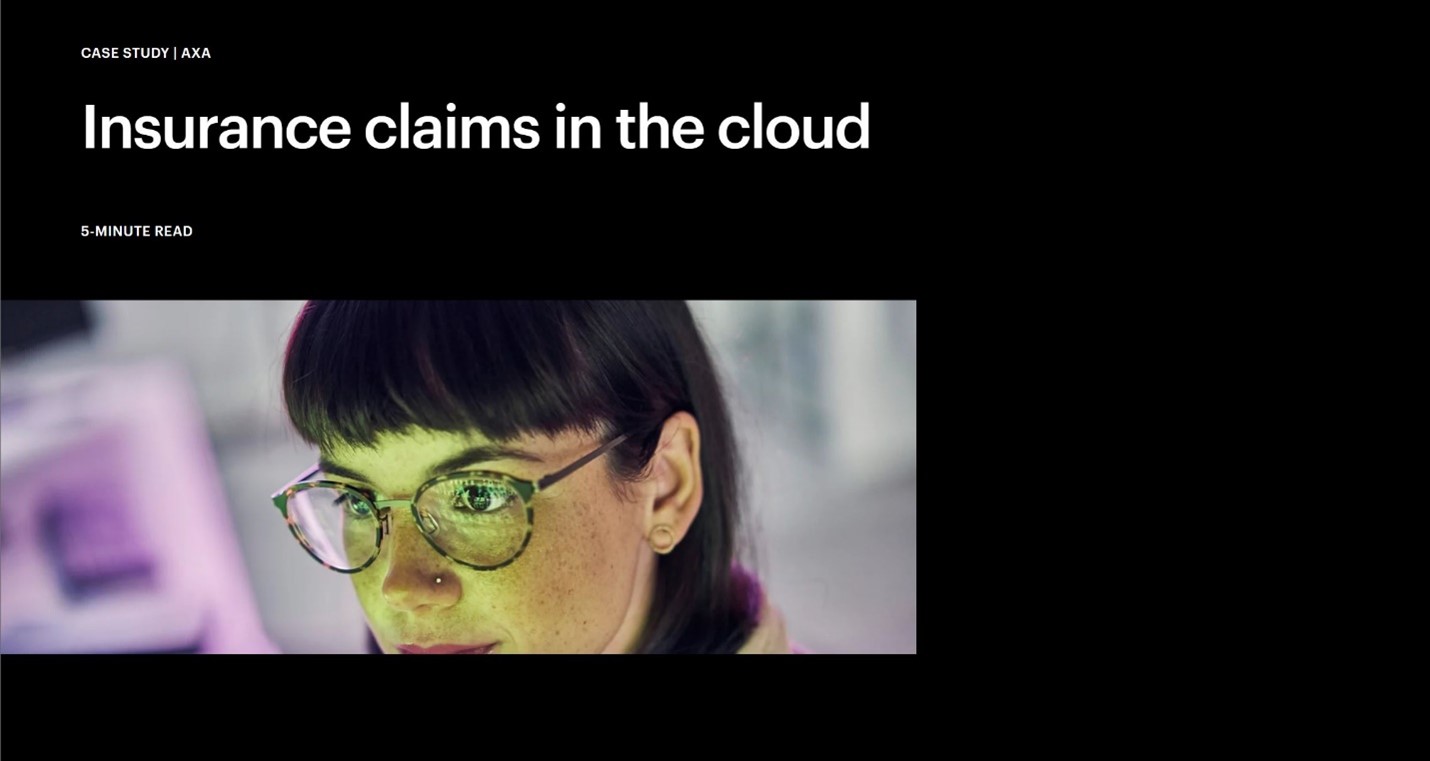
The AXA case study is powerful because it gets to the point quickly. Accenture summarizes the customer challenge and solution in the first paragraph. Readers learn more about the solution and results without a wall of words. In addition, the dark screen makes the copy and graphics pop.
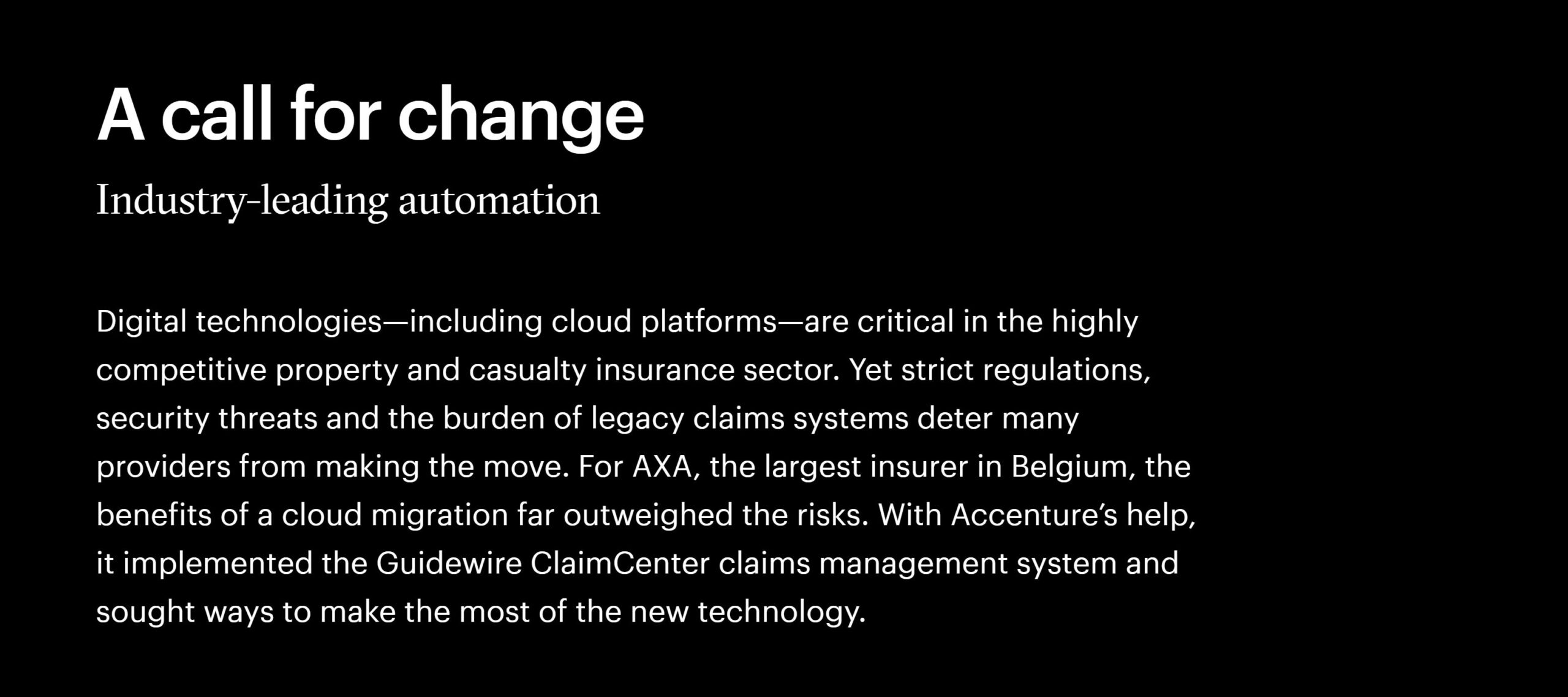
Finally, the case study calls out the results to show that Accenture’s solution helped AXA achieve its goals.
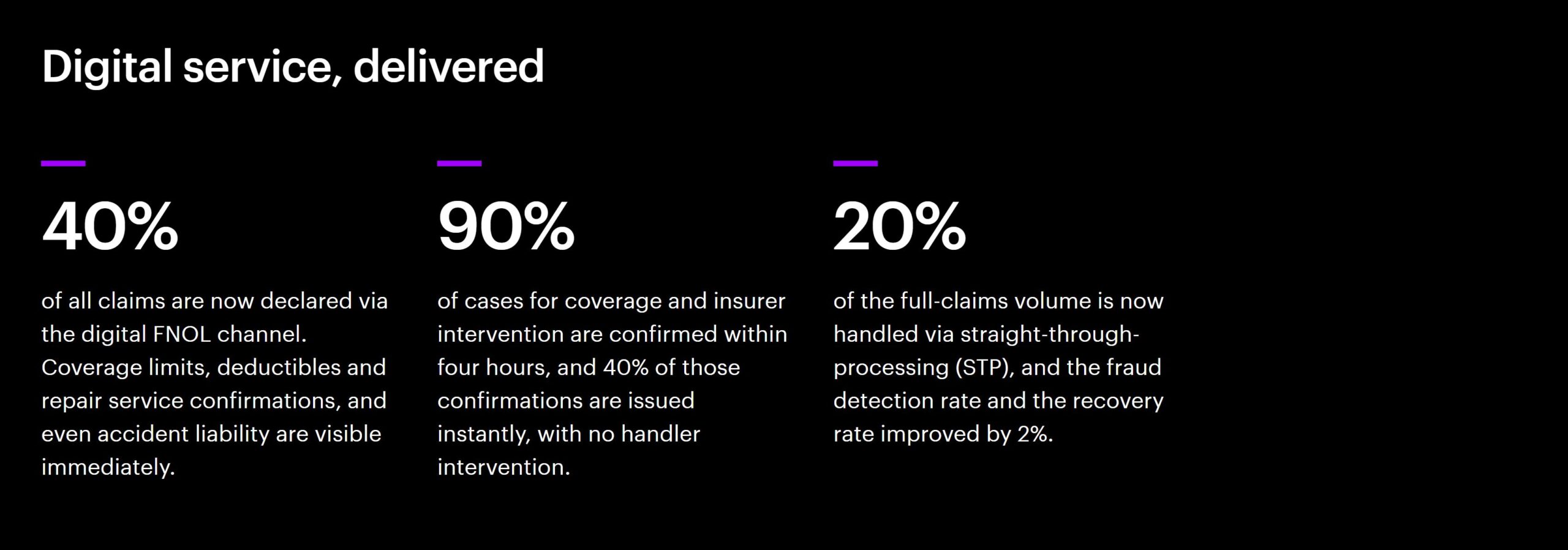
What you can learn from this and do:
- Tell a strong story concisely.
- Appeal to skim readers with subheads and short paragraphs.
- Provide specific success metrics.
- Humanize your brand with people photos.
What they could have done better:
- Include a CTA: After the results, buyers are left hanging with the website footer menu. This would have been the place to tell them what to do next. Be sure to encourage buyers to take action, such as downloading a white paper or contacting you to learn more.
- Include at least one customer testimonial: Testimonials are essential proof that brands deliver on their promises and meet customers’ expectations. Always aim to quote decision-makers because their feedback is more persuasive than that of low-level stakeholders.
2. Salesforce: Ponce Bank
Brands must work hard to get people to read beyond headlines and bullet points. Salesforce succeeds in doing that with its Ponce Bank case study.
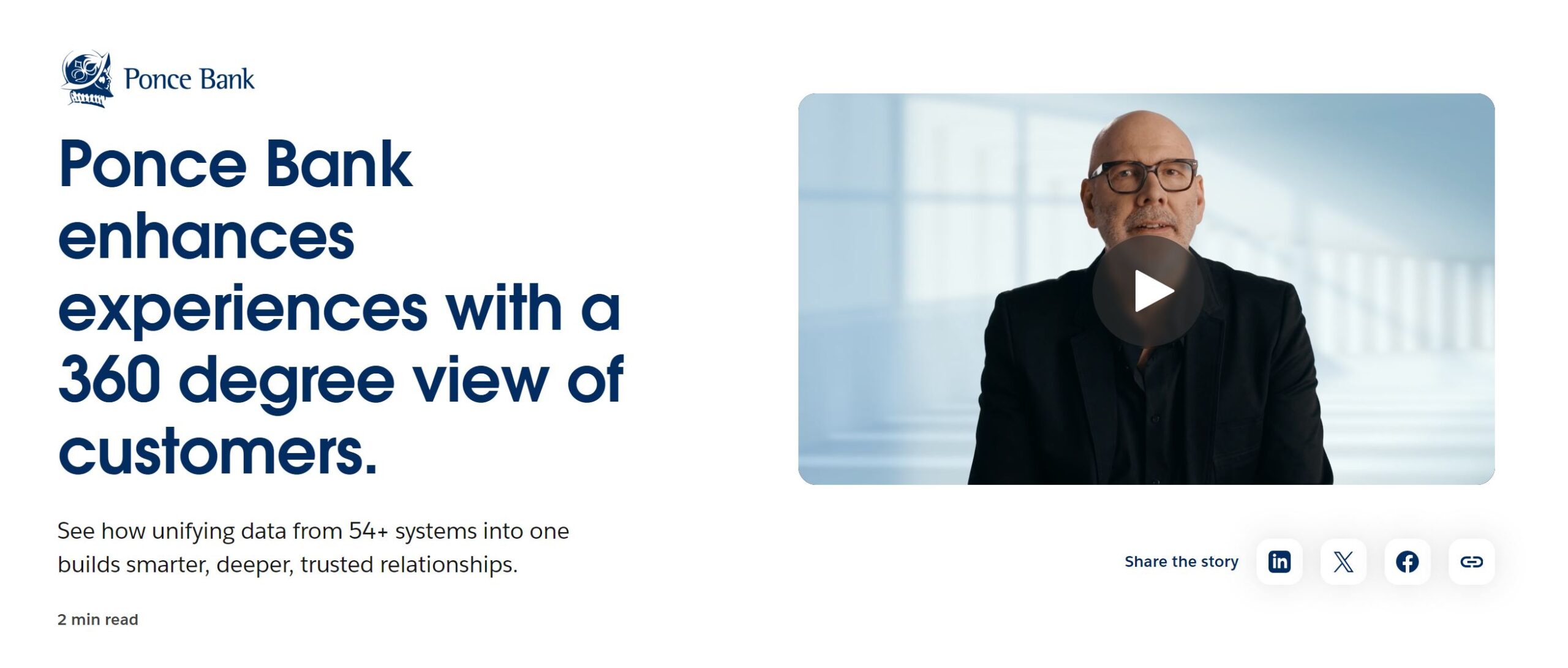
In particular, the customer video engages buyers immediately. In less than two minutes, the bank’s professionals explain their challenges and how Salesforce helped them. Those who’d rather read the story can get the details in two paragraphs: “What you need to know” and “Why it matters.” The customer testimonial reinforces the results, as does the three bullet points in the “What the difference looks like” section below the quote.
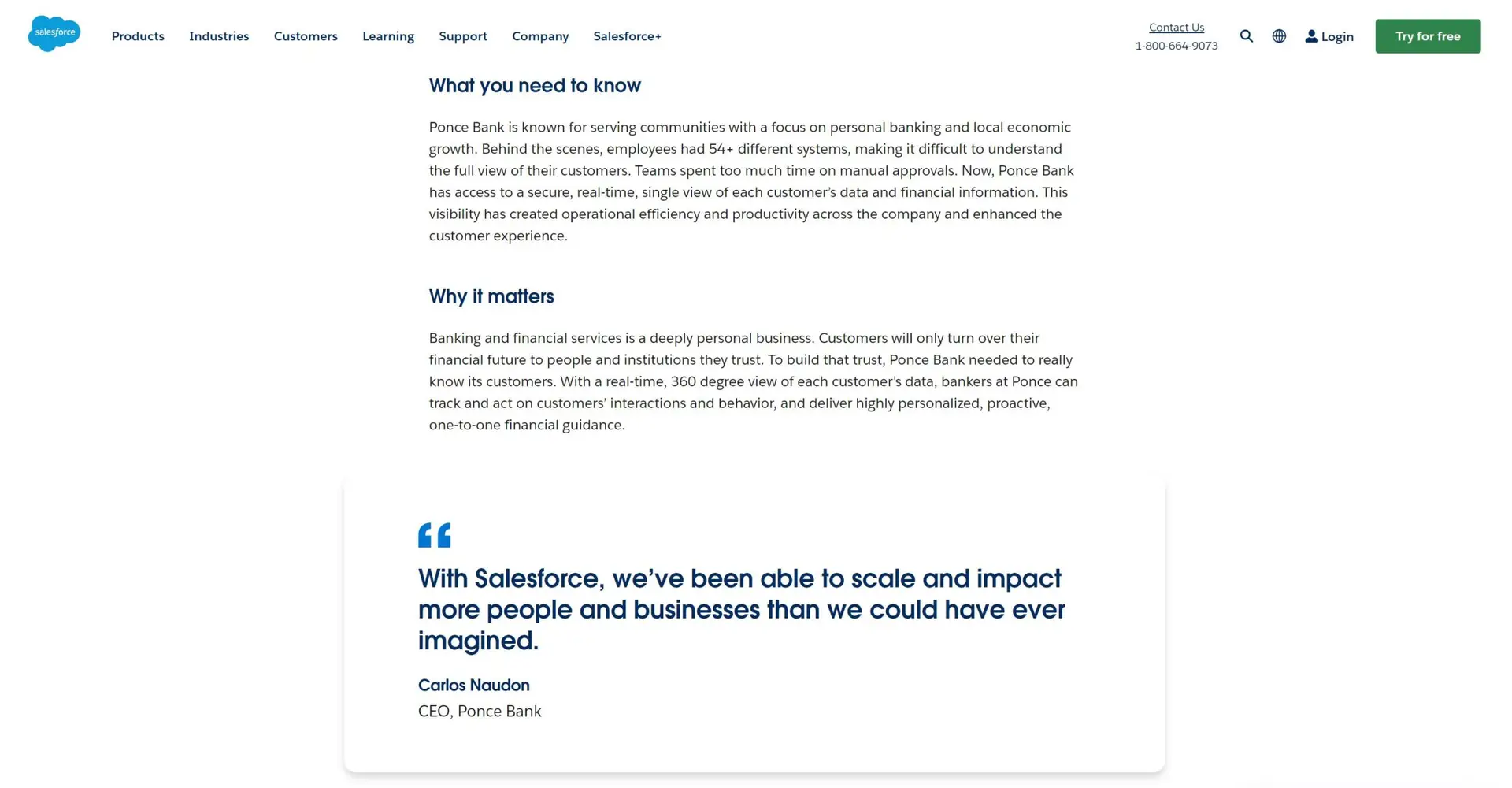
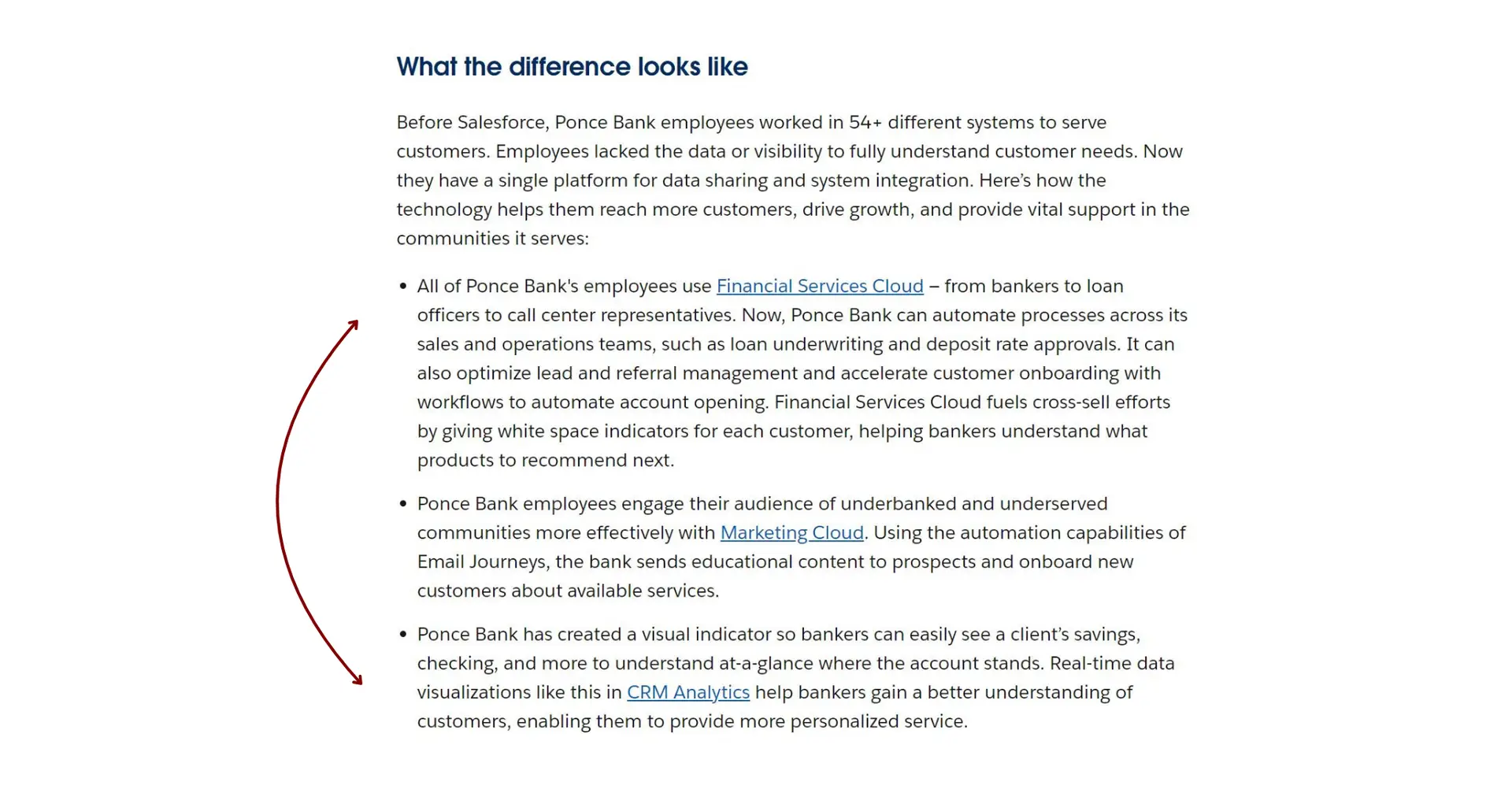
But even if buyers only look at the headline and subhead, “See how unifying data from 54+ systems .. builds smarter, deeper, trusted relationships,” they learn the customer benefit. And notice how these elements are up top to avoid scrolling? It’s a smart, effective strategy. No matter what devices buyers use to access the case study, they see these two points.
What you can learn from this and do:
- Condense each customer problem and strongest result into a short headline or teaser that you place at the top of your case study.
- Structure your content with the most compelling, high-level information first. Provide more details in subsequent sections.
- Appeal to buyers in the ways they prefer to consume content by having a mix of video, copy and graphics.
- Improve trust in your solutions by including a written testimonial if video isn’t an option for you.
What they could have done better:
- Include a CTA: The Ponce Bank case study doesn’t have a direct CTA, but it includes links to the relevant Salesforce products.
3. Dell Technologies: ATN International
Dell Technologies makes the most of its full-width ATN International case study by putting the customer need, Dell’s solution and the No. 1 result at the top.
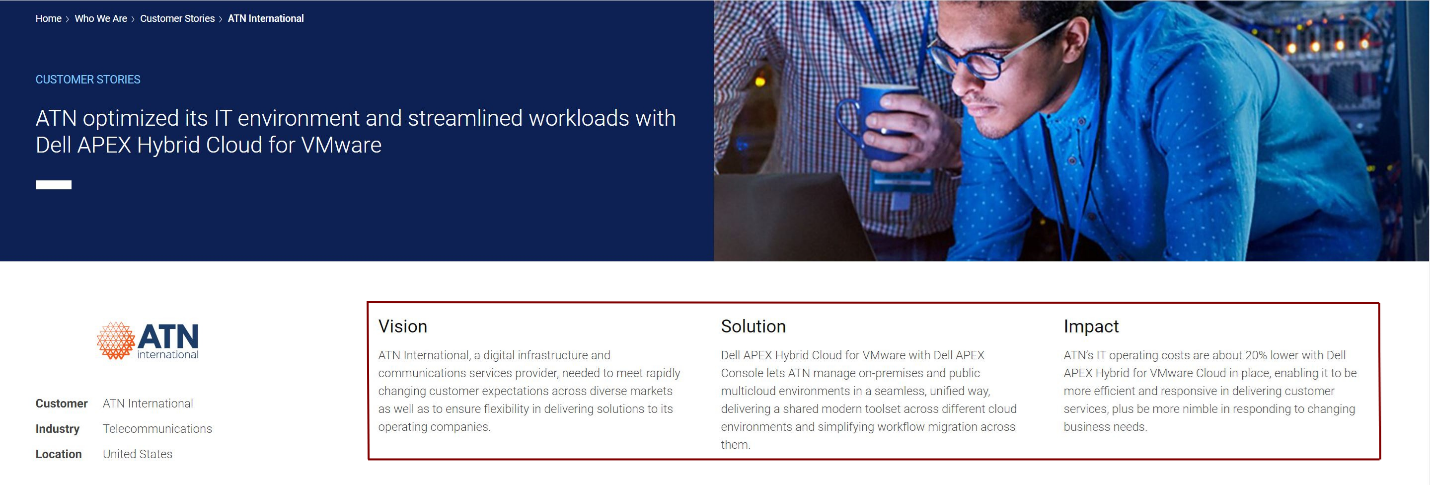
To increase engagement, the company included a customer testimonial, a button to download a PDF for the full story and a video of the chief information officer at ATN International talking about Dell Technologies’ solution.

Next, the case study highlights other results ATN achieved in the “Business Results” section. Having three to four customer outcomes per case study is ideal. Finally, Dell includes CTAs for its relevant solutions. Another nice touch: The company invites buyers to get answers to their questions in multiple ways.
What you can learn from this and do:
- Make it easy for buyers to find your customers’ challenges, your relevant solutions and the outcomes.
- Give buyers the option to read a full-length PDF for each case study should they want to delve into the details.
- Increase engagement and SEO benefits with strong CTAs that drive buyers further into your website.
What they could have done better:
- Avoid redundancy: Stating that you reduced a customer’s costs by 20% is great, but it’s overkill to include it three times. An easy fix would be to feature a different testimonial.
4. SAP: Nestlé S.A.
SAP immediately targets buyers who prefer to see and hear customer results by putting a link to its Nestlé S.A. video case study in the header image. With such a recognizable brand win, SAP is banking on the power of video to sell the story. As a result, the company features two additional videos on the page.

But SAP knows it can’t rely on video alone. It expands the story with big results, three written testimonials and a full-length challenge, solutions, results narrative. Those who don’t want to read that much content will find the list of customer benefits and relevant SAP solutions at the end. Yes, this is a lot to wade through, but it’s a marquee customer, and SAP wants to make the most of it.
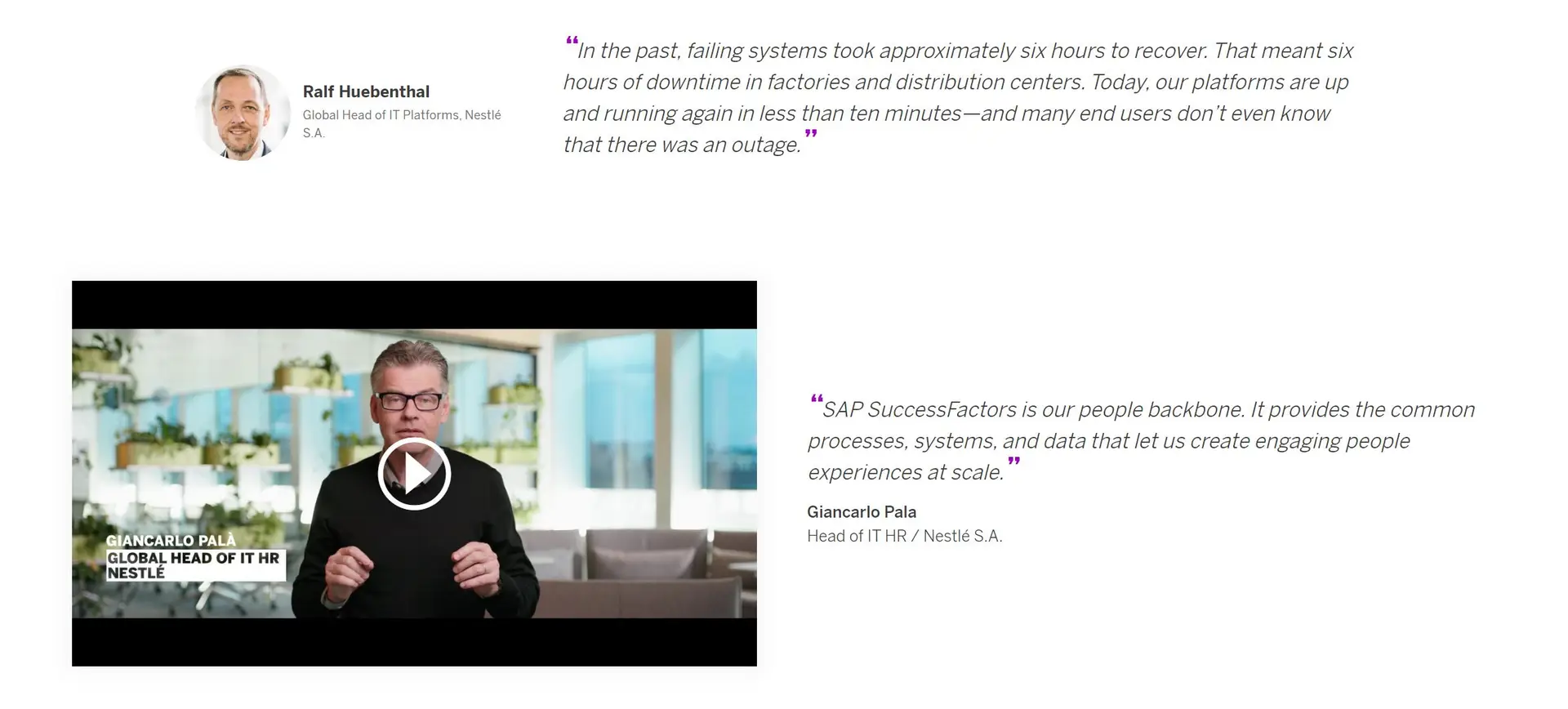
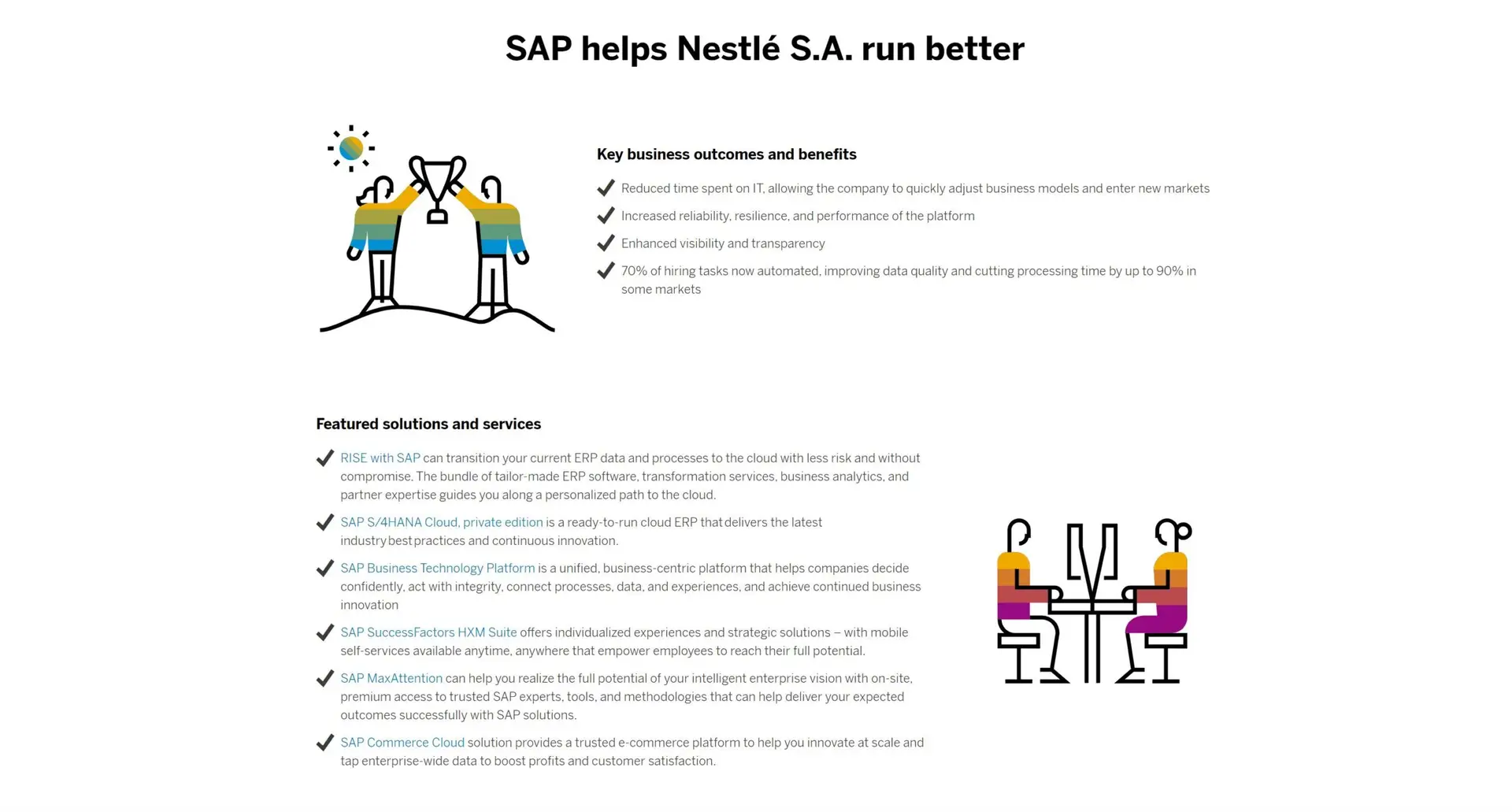
What you can learn from this and do:
- If your customers include enterprise brands, approach them for case studies first. Getting commitments often takes longer than with lesser-known businesses. And if they agree to participate, create as many assets as you can for your marketing and sales efforts.
- Break up long copy blocks with subheads, bulleted lists, infographics, testimonials and images.
What they could have done better:
- Include a clear CTA: While SAP might consider the links to its solutions/services to be sufficient, they’re buried at the bottom in a long list. In addition, when you give buyers so many choices for next steps, it can overwhelm them.
5. Sendoso: PatientPop
In its PatientPop case study, Sendoso makes it clear what it wants prospects to do: book a demo. The CTA appears at the top and bottom of the page. Some marketers might object to putting a CTA before the “meat” – meaning social proof that the platform works. But the first reference appears immediately under the benefit-driven headline and teaser, so I don’t think it’s an issue.
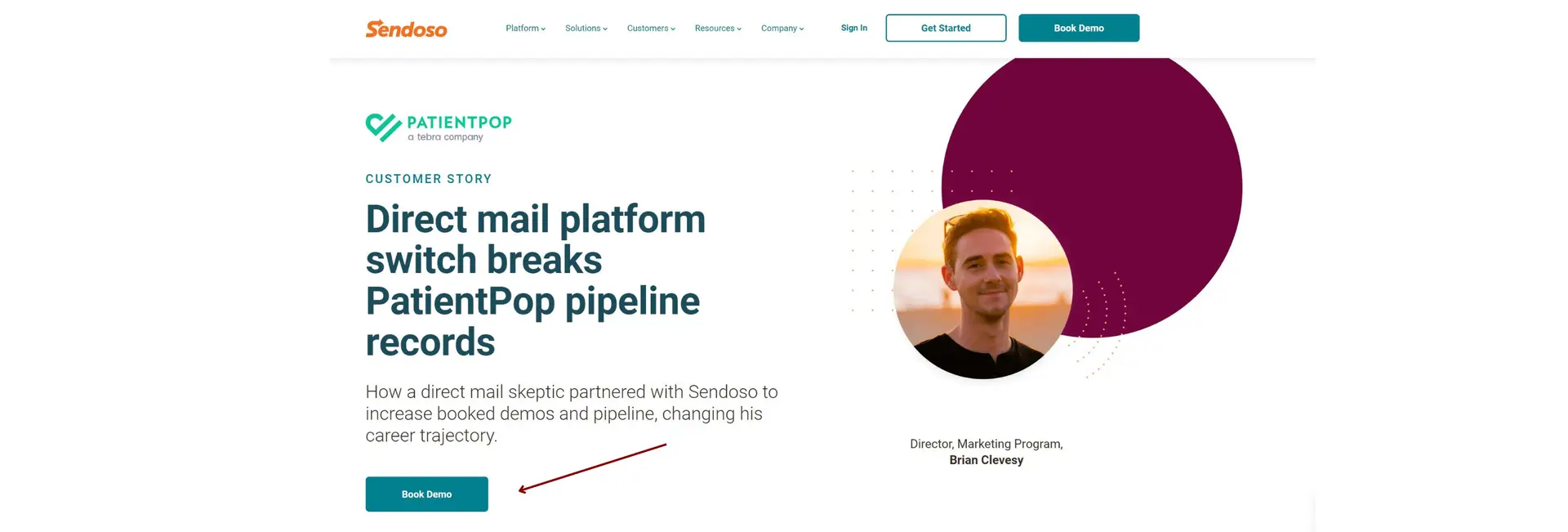
Sendoso gets to the challenge, solution and results quickly. The story is an easy read, with short paragraphs of one or two sentences each, mixed in with customer quotes. It ends with a ringing endorsement for Sendoso. The CTA that follows is a natural request after such a positive narrative.
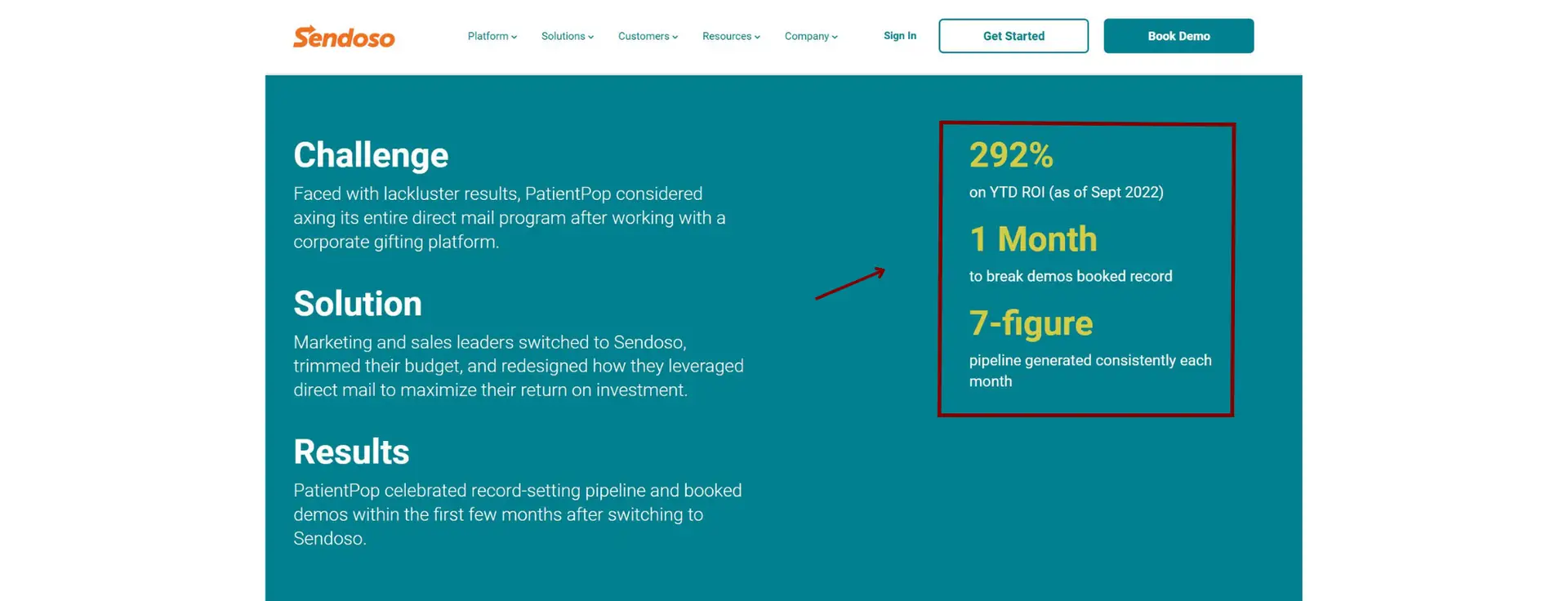
What you can learn from this and do:
- Asking buyers to complete one activity will get you a better response rate than if you bombard them with multiple requests. If you use a case study to ask them to contact you, register for a webinar, read your latest blog post and check out your user guides, you’ll overwhelm them.
What they could have done better:
- Include a video synopsis or video testimonial: B2B marketers are increasingly shifting their focus to video because it attracts a broader audience than copy-only case studies.
Bonus case study tip
If you can develop case studies for all of your audience segments, you’ll be able to target and attract more buyers than if you generalize. Prospective customers want content that speaks to their individual industries and needs. In short, add strong sorting capabilities on your site so that buyers can find what they’re looking for quickly.
For example, buyers can search for SAP customer stories by industry, product, country and company size. And they can enter a keyword or phrase in the search field. These options make it easy to home in on precise results.
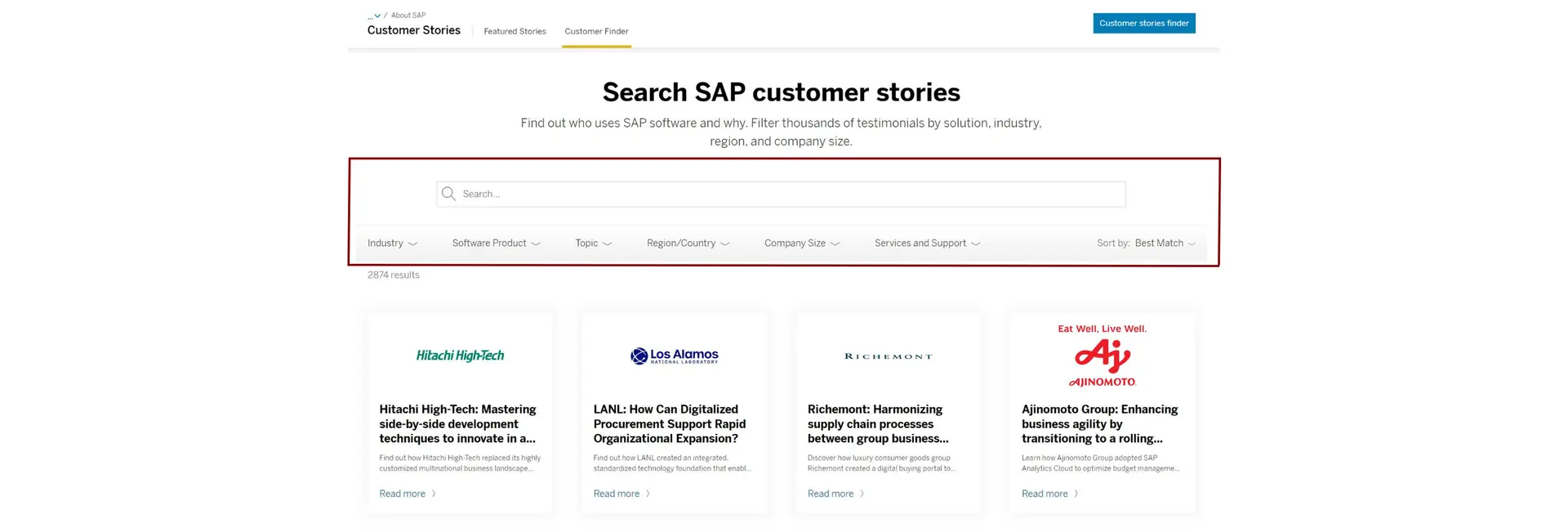
Meanwhile, Dell Technologies uses a similar approach, with filters for industries, topics, location, products, solutions and services.
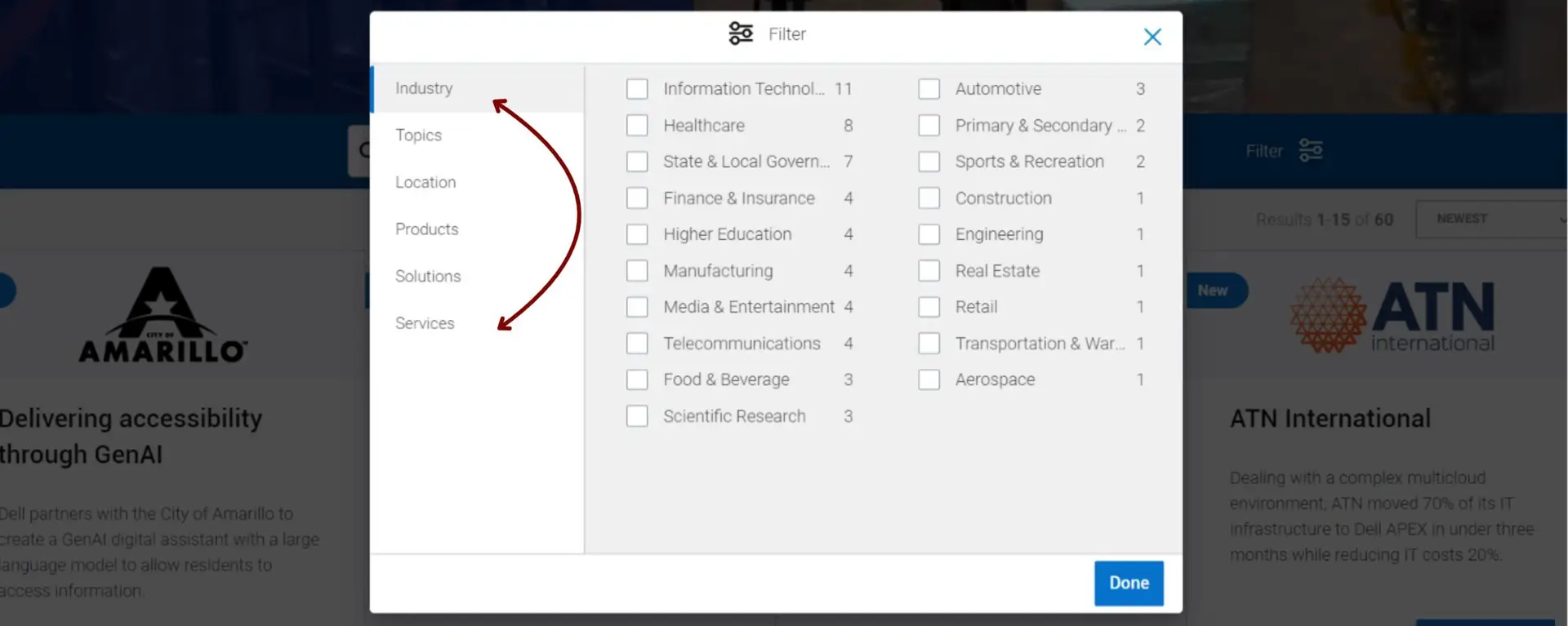
For the last example, Sendoso takes a different approach for its case studies. Buyers can select a specific topic from the “jump to” menu at the top to access the content within those categories.
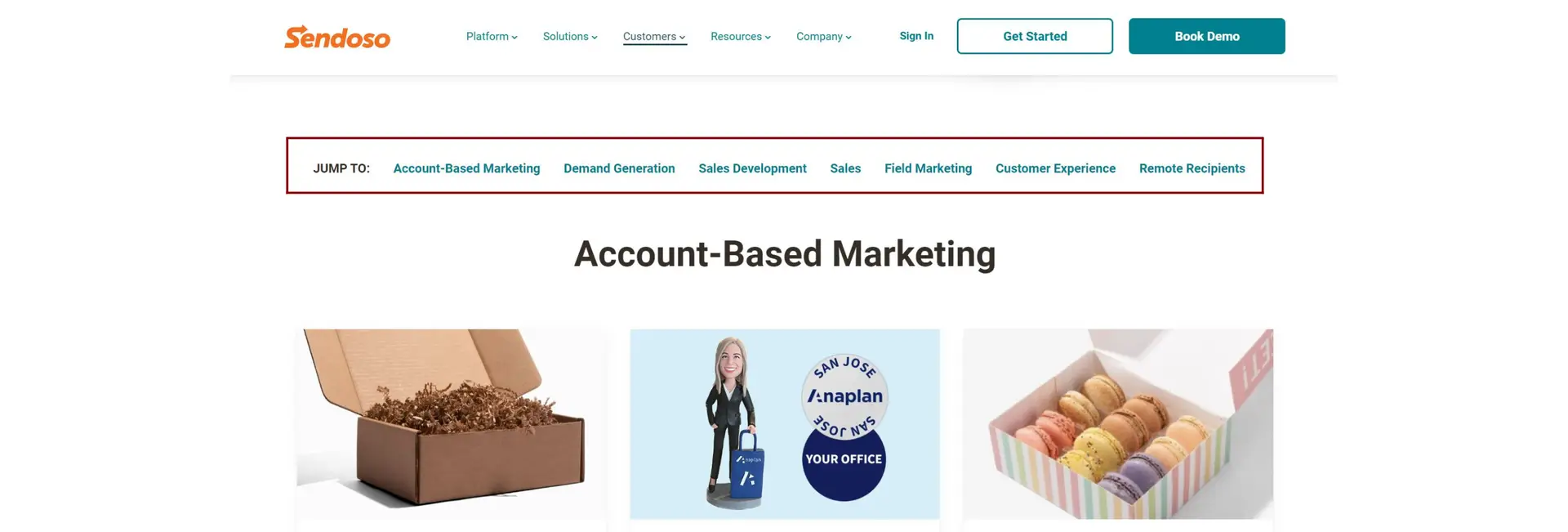
Building trust builds business
Case studies are an important part of the customer journey. They help convince prospective customers that you deliver on your promises. B2B buyers want to know that your products and services will provide real benefits and results. By sharing concrete examples and strong outcomes, you’ll earn buyers’ trust – and their business.

